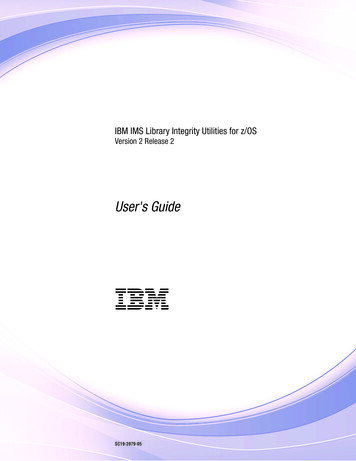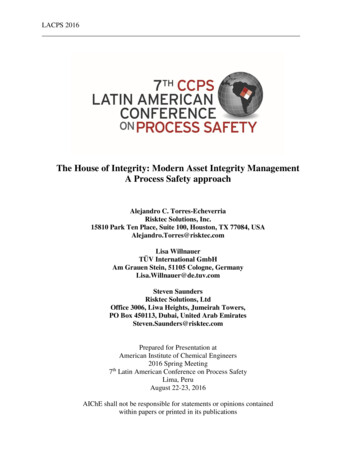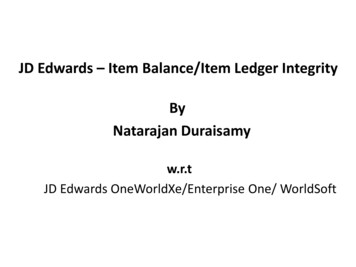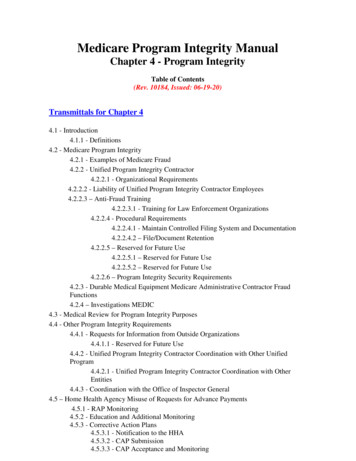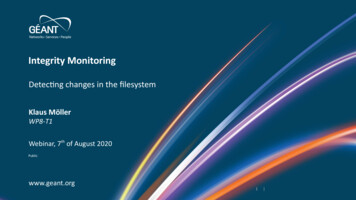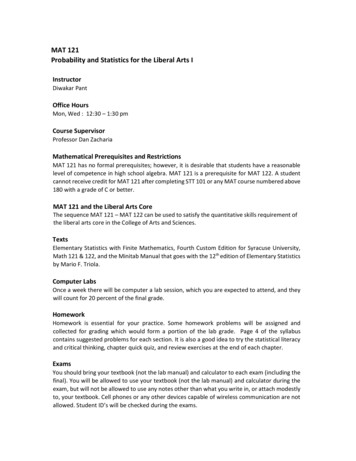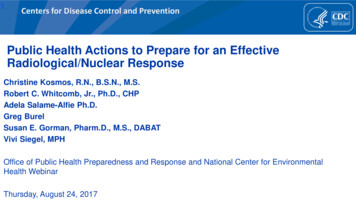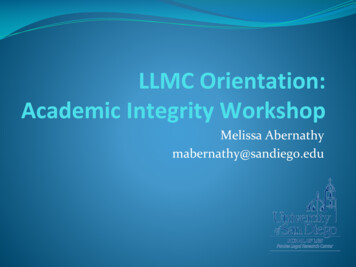
Transcription
LLMC Orientation:Academic Integrity WorkshopMelissa Abernathymabernathy@sandiego.edu
USD School of Law Honor CodeThe University of San Diego School of Law is committed to providing a legaleducation in an environment free from injustices and academic dishonesty. This Honor Code establishes the rules that govern the students of theUniversity of San Diego School of Law for all conduct relating to academicmatters. By virtue of enrollment at the University of San Diego School of Law, allstudents are on notice of this Honor Code and its provisions. Each student is responsible for reading, understanding, and complying withthis Honor Code and for reporting any violations of the Honor Code.-USD School of Law Honor tudent-handbook/honorcode.php
I. Academic DishonestyAcademic dishonesty is a violation of this Honor Code.1. Violations may include, but are not limited to:a. Examination Behavior.b. Fabrication.c. Unauthorized Collaboration.d. Plagiarisme. Misappropriation of Resource Materials.f. Unauthorized Access.g. Violations Defined by Instructor or Supervisor.h. Violations Defined by Student Boards in Academic Matters.2. A violation may be either an infraction or a serious violation.-USD School of Law Honor tudent-handbook/honor-code.php
II. Academic Dishonesty: Sanctionsand Procedures The instructor or supervisor must determine whether (A) no act of academicdishonesty has occurred, (B) an infraction has occurred, or (C) a seriousviolation probably has occurred. Minor infractions may result in a reduction in grade, withdrawal from thecourse, retaking of the course, additional work for the course. Serious violations are handled by the Honor Code Hearing Committee andcan result in expulsion, suspension, a letter of censure, the need for additionalcourses or credits, or other sanctions.-USD School of Law Honor tudent-handbook/honor-code.php
Consequences of AcademicDishonesty In re Zbiegien, 433 N.W.2d 871 (Minn. 1988) (investigating anincident of plagiarism while an applicant was in law school delayedthe applicant’s bar application for one year while the committeeconducted its investigation) In re Harper, 645 N.Y.S.2d 846 (N.Y. App. Div. 1996) (discipliningattorney for failing to disclose on his NY bar application that he wasdismissed from a L.L.M. degree program because he was found tohave plagiarized a paper) In re Lamberis, 443 N.E.2d 549 (Ill. 1982) (censuring attorney forplagiarizing a thesis paper in a L.L.M. program and stating “sanctionsare appropriate and required because both the extent of theappropriated material and the purpose for which it was used evidencethe respondent’s complete disregard for values that are mostfundamental in the legal profession”)
Plagiarism and How toAvoid It
Understanding Plagiarism Plagiarism is the presentation of another person'swork as your own. summarizing, paraphrasing, copying, or translatingwords, ideas, or any other creative work,without proper attribution.Plagiarism can be deliberate or accidental; partial orcomplete. - Plagiarism Tutorial by Ramona Islam, Fairfield University
Examples of Plagiarism Buying, stealing, or ghostwriting a paper Copying and pasting or using other people’s ideaswithout attribution. Paraphrasing an author too lightly
Ensuring Proper Attribution The first step in avoiding plagiarism and giving properdocumentation is to cultivate good note-takinghabits. As you take notes, include the bibliographicinformation you’ll need later for a citation. You maywant to take advantage of note-taking software likeEvernote and Zotero. If you cut & paste text from another source to look atlater, immediately mark it as copied text. Likewise, if you paraphrase material, make sure it ismarked clearly with your changes.
Ensuring Proper Attribution (cont.) Double-check your work against each source to makesure you have not accidentally plagiarized something. Save copies of source material (journal articles, books,online sources) until you have finished writing yourpaper or until you’ve received a final grade on thepaper.
Paraphrasing Paraphrasing is restating the meaning of a segment of texteither by expanding and clarifying, or by summarizing the mainpoints. However, it's not enough to simply change a few words around, orreplace words with synonyms. Instead, you must rewrite the material using your own words. Always indicate whose ideas you are paraphrasing by providinga footnote reference (including a page reference) Finally, check your paraphrase against the source for accuracy,and modify phrases that match the original too closely.
Bad ParaphrasingOriginal Source:“America today has veeredtoo far in the direction offormal testing withoutadequate consideration of thecosts and limitations of anexclusive emphasis on thatapproach.”Paraphrase Version 1:America has now gone toofar toward formal testing,without realizing the costsand limitations ofexclusively emphasizingthat approach.11HOWARDHOWARD GARDNER, MULTIPLEINTELLIGENCES: THE THEORY INPRACTICE 179 (1993).GARDNER,MULTIPLE INTELLIGENCES:THE THEORY IN PRACTICE179 (1993).
Comments Although the source is cited, the paraphrasing retainstoo much of the original wording and sentencestructure.
Better ParaphrasingOriginal Source:“America today has veeredtoo far in the direction offormal testing withoutadequate consideration ofthe costs and limitations ofan exclusive emphasis onthat approach.”HOWARD GARDNER,MULTIPLE INTELLIGENCES:THE THEORY IN PRACTICE179 (1993).Paraphrase Version 1: In theUnited States, the educationsystem places too muchemphasis on formal testing,overlooking the limitationsand expenses imposed whenthat assessment strategy isemployed exclusively.11HOWARDGARDNER, MULTIPLEINTELLIGENCES: THE THEORY INPRACTICE 179 (1993).
Comments This paraphrase is different enough from the originalsource that it would not be considered plagiarism, aslong as Gardner is credited.
More Practice and Quizzes Indiana University, How to Recognize Plagiarismhttps://plagiarism.iu.edu/ Harvard Law School, Plagiarism Quizhttps://harvard.az1.qualtrics.com/jfe/form/SV 71fT8VnVotpnUep CALI Lesson – Plagiarism – Keeping out of Troublehttps://www.cali.org/lesson/1119
Turnitin at the LRC Turnitin at the LRC is an area in Blackboard wherestudents can submit drafts of papers to check for possibleinstances of plagiarism before they submit final drafts totheir course instructors. Turnitin is FREE to USD students. Papers submitted through Turnitin at the LRC will not besaved in Turnitin’s database and will not be distributed toinstructors. For more instructions, see our Turnitin LibGuide.
Similarity ReportTurnitin compares submitted drafts to its database of scholarly research(journal articles, student papers, and other internet sources) and returns aSimilarity Report that highlights a percentage of matching text.
How to use TurnitIn at the LRC1.Email mabernathy@sandiego.edu to be added to the LegalResearch Center Organization2.When you are ready to submit your paper, login toBlackboard at https://ole.sandiego.edu/ultra/organizationand click on the Legal Research Center under theOrganizations tab.1.Click on Organization Content1.Click on Student Turnitin and upload your document.1.Wait for a Similarity Report. Similarity Reports should usuallybe ready within 1 hour, and most are returned within a fewminutes.
Questions? Need help?Contact a librarian! Melissa AbernathyForeign & International Law Librarianmabernathy@sandiego.edu(619) 260-4734 Reference Desklrcrefer@sandiego.eu(619)260-4612
Understanding Plagiarism Plagiarism isthe presentation of another person's workasyourown. summarizing, paraphrasing, copying,or translating words,ideas, or any other creative work, withoutproperattribution. Plagiarism can be deliberate or accidental; partial or complete. -Plagiarism Tutorial by Ramona Islam, Fairfield University

